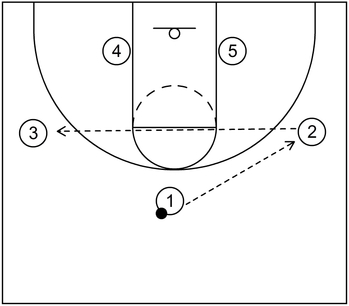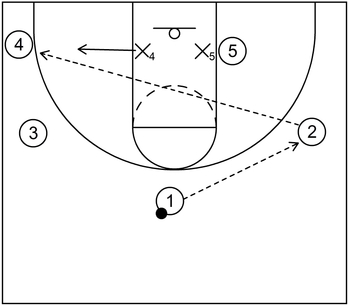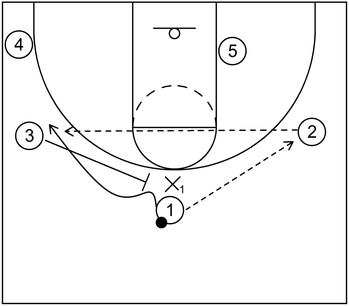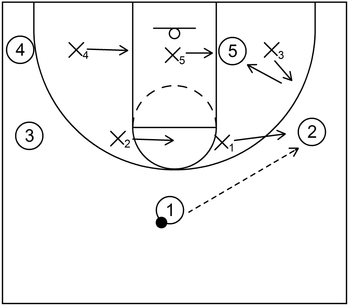What is the skip pass in basketball
The skip pass consists of action that occurs when an offensive player in current possession of the basketball passes it to another non-adjacent offensive player, usually on the opposite side of the court.
Why is it referred to as a skip pass
It is commonly referred to as a skip pass because the ball is being skipped over the nearest offensive player that could possibly receive it towards another offensive player that is further away from the current location of the ball.
Essentially, each of the five offensive players should generally fill one of the main areas of the court which are the top, the slots, the wings, the corners, or the high/low post areas.
As a side note, this also follows good basketball spacing concepts as well.
Afterwards, if an offensive player has possession of the ball in one of those areas, the nearest adjacent area is considered one pass away.
That means that the offensive player with the ball only has to execute one pass to move the ball to the next adjacent area of the court.
For example, let’s say that the offensive team would like to move the ball from the top to either the left side wing or right side wing.
To accomplish this simple objective, the offensive player at the top in current possession of the ball only has to execute one pass to move the ball from the top to either wing area.
Conversely, if an offensive player has possession of the ball in a certain area of the court, any non-adjacent area is consider two or more passes away and this is where the concept of the skip pass comes into effect.
For example, let’s say that the offensive team would like to move the ball from the right side wing to the left side wing.
To achieve this objective with conventional basketball passing, the offensive player in possession of the ball would have to pass it to another offensive player at the top.
Following that, the offensive player at the top would then have to pass it again to a third offensive player that filled the left side wing.
As a side note, this is typically known as ball reversal or reverse passing.
Normally, this type of conventional passing is usually suitable most of the time for basketball offensive strategies in general.
However, the potential disadvantage to this standard passing is that it is slightly slower to move the ball from one particular area to a non-adjacent area that is further away from the ball.
When that occurs, it could allow the defensive team more time to contain the ball, particularly by executing the defensive closeout tactic.
As a result, this could make it more difficult for the offensive team to create dribble penetration or take high percentage open jump shots.
Therefore, the offensive team could utilize the skip pass to alleviate that possible issue.
Let’s revisit the previous example in which the offensive team wanted to move the ball from the right side wing to the left side wing.
Instead of using conventional passes (which in this case, would include two passes), the offensive player in possession of the ball near the right side wing could simply skip over the offensive player at the top to move the ball quickly to the left side wing.
Essentially, with a skip pass, the offensive player on the right side wing only has to execute one pass to move the ball at least two areas away from their current location.
In other words, the skip pass could be thought of as an offensive player executing one pass for the price of two or more passes.
How should an offensive player typically execute the skip pass
Generally speaking, an offensive player should execute the skip pass by utilizing an overhead pass.
That is to say, the offensive player should place the ball over (or above) their head and then quickly move their arms forward, snap their wrist, and release the ball towards the target.
It should also be mentioned that it is possible to use a standard chest pass when executing the skip pass action if the player is strong enough to effectively utilize that chest pass, particularly when the target is two or more passes away.
However, the primary reason why the overhead pass is commonly used as opposed to the chest pass is because the skip pass itself needs to be a very quick pass with an adequate amount of velocity.
In other words, if the skip pass is too slow, then the defense will have a substantial amount of time to react to that pass. Then, from that point, the defender that is closest to the ball will have enough time to prevent or hinder the open jump shot or possible dribble penetration with a defensive closeout.
What are the general benefits of using the skip pass
The general benefits of using the skip pass is that it could be potentially effective against weak side defenders that provide help in the lane too far away from their assignments. Furthermore, the skip pass could be possibly useful against zone defense and it could also be utilized in combination with the flare screen to create potential scoring opportunities near the perimeter areas of the court.
Potentially effective against weak side help defense
The skip pass could be potentially effective against help defense on the weak side, especially if a weak side defender, particularly during man to man defense, helps in the lane and therefore, moves too far away from their current assignment.
For example, let’s say that an offensive player has possession of the ball on the right side wing and that same offensive player would like to pass it to an above average low post scorer near the right side low post block.
At the same time, let’s also say a weak side defender near the left side corner leaves their assignment and slides into the lane to provide help in the event that the dominant low post player were to receive the ball.
The weak side defender may attempt to do this because the ball is technically at least three passes away from their current assignment.
However, to counter that defensive action, the offensive player near the right side wing could then skip the ball to the offensive teammate near the left side corner that was previously covered by the helping defender.
When that occurs, the weak side helping defender that is assigned to the offensive player near the left side corner will most likely not have enough time to execute a proper defensive closeout which could lead to a potential open jump shot for the offensive player in the left corner.
Moreover, even if the jump shot is not available, that same weak side defender assigned to the left side corner may execute a poor closeout which would then allow the offensive player that received the ball in the corner via the skip pass to get dribble penetration.
Afterwards, the corner offensive player in possession of the ball could dribble all the way to the basket for a layup or dunk, shoot a floater or runner in the lane, or perhaps, execute a kick pass so that another offensive teammate might have an opportunity to score or make a play.
Potentially effective against zone defense
The skip pass could be effective against zone defense because the zone defenders cover areas of the court as opposed to guarding against actual offensive players.
Therefore, when ball movement, and more specifically, ball reversal occurs during offensive execution, this causes the zone defenders to shift from one area to another.
As that occurs, this will generally create gaps within the zone defense. From that point, the offensive team could produce high quality jump shots, especially from three-point range.
Additionally, the offensive team could get dribble penetration into the gaps of the zone, similar to what was mentioned in relation to a weak side help defender.
In other words, when the ball gets skipped from one area, and more particularly, from one side of the court to another side, the zone defender that is assigned to cover the new area may not have enough time to effectively closeout to prevent an uncontested jump shot.
Furthermore, that same zone defender could possibly execute an inefficient closeout which could then lead to dribble drive action into the gaps of the zone.
Potentially effective in combination with the flare screen
The skip pass can be used in combination with the flare screen to create a possible scoring opportunity.
Basically, when the ball is on one side of the court, it could be challenging for a defender that is being screened to keep track of the ball, their own assignment, and the screener setting the flare screen.
From that point, if the defender being screened gets caught on the flare screen, then the player receiving the ball via the skip pass could have a wide open shot.
Moreover, even if the defender being screened is able to avoid the flare screen, the screener could then flip the screen into pick and roll or pick and pop action.
This essentially means that the defender would have to avoid at least two basketball screens : the original off-ball flare screen and the current on-ball screen.
That could be very difficult to accomplish for most defenders, especially if those same defenders are not at an elite level in terms of defensive ability and defensive IQ.
Also, even if the screener’s defender decides to execute a defensive switch, that could create a whole new set of problems, especially if the screener’s defender as well as the screener are post players.
In other words, if the screener’s defender executes a defensive switch to mitigate the effect of the flare screen but that same defender is not quick enough to contain the offensive player that received the ball after the flare screen action occurs, then this is essentially a defensive mismatch.
From that point, the defensive mismatch would most likely lead to easy dribble penetration towards the basket or at minimum, an open jump shot which could be the result of utilizing one or more dribble moves to create space between the offensive player with the ball and the on-ball defender.
What is a potential downside of the skip pass
A potential downside of the skip pass is that an off-ball defender, particularly near the weak side, could possibly deflect or intercept the pass because the ball is in the air for a longer period of time and it covers more space than a standard chest pass or bounce pass to an adjacent offensive player.
Furthermore, if a defender does indeed intercept the skip pass as opposed to simply deflecting it, then that would be a unfortunate turnover for the offensive team.
Therefore, offensive players should be adequately skilled at standard passing, and more specifically, making adjacent overhead passes before executing skip passes on a consistent basis.
What are simple examples of the skip pass in basketball
Example 1

This is an example of a skip pass from one wing of the court to the opposite side. To start, 2 receives the ball from 1 and then executes a skip pass to 3 on the left side wing.
In this instance, instead of 1 receiving the ball again from 2 and afterwards, 3 receiving the ball from 1, the ball was simply skipped over 1 at the top. In other words, 2 was able to execute only one pass for the price of two.
Example 2

This is an example of a skip pass that occurs from one wing of the court to the opposite corner. To start, 2 receives the ball from 1 and following that, X4 slides into the lane to provide help if necessary against 5.
To counter that defensive action, 4 could receive the ball via the skip pass from 2. When that happens, X4 may not be fast enough to execute a proper defensive closeout on 4.
As a result, 4 might be able to take an open jump shot or possibly get dribble penetration towards the basket.
Example 3

This is an example of a skip pass that occurs in combination with a flare screen. To begin, 2 receives the ball from 1. Following that, 1 cuts to the left side wing area via the flare screen set by 3.
Next, 1 could receive the ball again from 2 via the skip pass and take the three-point shot if open.
Example 4 – Part 1

This is an example of the skip pass utilized against the 2-3 zone defense alongside a flare screen as well. To begin, 2 receives the ball from 1. This causes the zone defense to shift towards 2.
Example 4 – Part 2

Next, 1 cuts to the left side wing via the flare screen set by 3 in addition to the baseline screen set by 4. Afterwards, 1 receives the ball from 2 by way of a skip pass and takes the three-point shot if open.